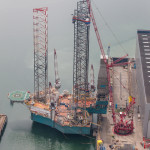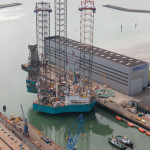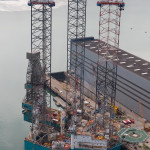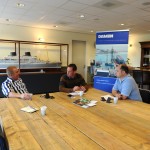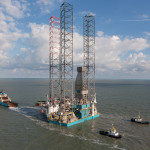Damen Raise Rowan Viking Using New Lifting Method
The skyline of Zeeland in the Netherlands, ordinarily the preserve of ancient towers and windmills, has recently been dominated by the legs of the Rowan Viking – a Keppel Fels N Class Drilling Rig that Damen Shiprepair Vlissingen have remodelled using a never before seen method that improves safety and reduces lead-time dramatically. Offshore Industry’s Ben Littler talks to Damen’s Bas Loohuis and Ron Brusket about the unique project.
The Rowan Group of Companies approached Damen Shiprepair Vlissingen to carry out three work scopes to be performed on the Rowan Viking. The contract comprised an extension of her three legs, a Special Periodic Survey (SPS) and Acknowledgement of Compliance (AOC) in accordance with NORSOK regulations.
The Tripod is Coming
The Rowan Viking’s next project will place her in Norwegian waters for Lundin Petroleum. This meant extension of her legs from 170 to 180m for operations in deeper waters.
Rowan were looking to get the work done within 130 days. Damen Offshore Conversion Group Commercial Manager Bas Loohuis takes up the story.
“The ordinary method is to place the leg extensions on board the platform, jack it up and use an onboard crane. You can imagine, though, when you are raised on a platform at a height of 150m, safety is an enormous issue. Plus, due to the rules, you’ll only have a skeleton crew up there. This means you aren’t able to execute the other scopes simultaneously. You first have to complete the leg extensions – only then can you move on to the next part of the project.
“We thought, ‘there has to be a better way’ and we came up with this method. We looked at it and we told the client we could do the same work within 100 days – and we did.”
High Jump
The method Mr Loohuis refers to involves use of Palfinger System’s Jack-up Maintenance Platform system – JUMP. The system involves building a closed habitat platform around the leg, which can then be raised and lowered.
The systems, however, were only a part of the solution. In order for the 127t extensions to reach the top of the platform legs, a crane had to be positioned on the quayside and facilitate lifts to a height of 200m.
The machine of choice was Mammoet’s largest PTC crane and preparing the way for it was a project in its own right.
Where House?
The location of the Mammoet crane required Damen to demolish an existing warehouse and relocate its operations elsewhere. With the building out of the way, DSV drove 70 poles of 20m length into the ground and introduced a 35m diameter, 2m thick concrete slab to tolerate the crane’s 30t/m2 footprint.
“Though there are crane operating sites elsewhere that can handle footprints such as this, this is the only quayside in Western Europe that has that capacity,” Mr Loohuis says.
Multi-Tasking
Whilst all this was going on, the SPS and AOC elements of the project could take place unhindered.
Alterations were made to the platform in order to comply with the AOC regulations, which are, explains Ron Brusket, Project Manager on the Rowan Viking project, “amongst the highest in the world.” For this scope DSV increased lighting levels on walkways and carried out noise and vibration checks at all workstations.
Damen chose Alewijnse for the electrical conversion of a number of important systems on the Rowan Viking. These included the conversion and engineering of several electrical distribution systems, plus installation of a completely new heli-fuel system and helideck status lights system, amongst other things.
Mr Brusket says that every aspect of the platform was covered. “Comfort is every bit as important as safety on a project such as this.”
Stay Sharp, Stay Safe
And safety certainly was a strong area of focus throughout the project, as Mr Loohuis explains. “Before each and every task toolbox meetings were carried out, checks done for hazardous operations, complete protocols and risk assessments. Of course, our partners Mammoet and Palfinger have excellent protocols for lifting heavy objects and we worked together as a team on this.”
Mr Brusket adds that it is important never to become complacent. “We had to stay sharp until the very end,” he says. The project passed off without a single lost time incident.
Winds of Fortune
There was also an element of luck involved with the weather. Mr Loohuis explains, “We were especially lucky in the lifting of the legs. To carry out the lifts from the quayside we had to have less than 10m wind per second – 5m per second in the case of the third leg – and we had those conditions on the morning we did it. In the afternoon we did not – the force was too high but, by then, we were finished.”
Offshore Ready
Damen is looking forward to more offshore refit and repair projects in the near future. “We have fifteen repair yards around the world,” Mr Loohuis says. “Two years ago, in mid-2012 we aligned them all so that they would be working together. In that line Damen Shiprepair & Conversion created a special task force “Offshore & Conversion.”
The team consists of experienced Commercial Management, Tender Management, Engineering, Project Management, Procurement Management, Planning, Document Control, QA/QC and HSE.
Visit Damen at Offshore Energy at booth nr 8.040 P









